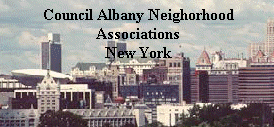| |
Neighborhood Works II
Concluding remarks by Paul M. Bray
In the interests of time of which there isn't much of at the end of an
informative and thought provoking conference, I would like to conclude by
highlighting four points:
1. Continue building civic capital. Last year Todd
Swanstrom ended the conference by talking about Albany's patron psychology and
sociologist Robert Putnam, author of Bowling Alone, who teach us about the
critical importance for cities and nations to be civically strong and active.
I want to reiterate this message that is especially important in a highly
politicized city like Albany where we have all politics all the time. We
all need to support civic initiatives and organizations like CANA, Albany
Roundtable, Historic Albany Foundations, Washington Park Conservancy and each
and every neighborhood association and social and charitable organization in
Albany. And we need great projects that come from the grass roots like
ArtWalk that Doug Rice from Rochester told us about. www.Rochesterartwalk.org.
Mayor Jennings, what happened to the Albany Educationway and Education Compact?
2. Cities like Albany can best prosper with many small
initiatives like the own a home projects in Schenectady and Troy to increase
resident home ownership and to upgrade all areas of the City.
Transformational or big developer projects may come along but they are not the
answer to a successful and livable city.
The following is a letter to the NY Times by Mayor Thomas M. Menino of Boston,
July 12, 1999
Better to Fix Up Cities Than Tear Them Down
To the Editor:
Re: "Slash-and-Burn Urban Renewal" (op-ed, July 9)
At a time when some cities are stepping up efforts to tear down abandoned
houses, my city is working harder to fix them up.
(skip two paragraphs)
Seizing a vacant, tax-delinquent property through the courts takes time.
It takes even more time to get that house sold, renovated, occupied and back on
the tax rolls. But fixing up these houses one by one is a better strategy
in the long run than tearing them down.
Every renovated home stabilizes a neighborhood, preserves its traditional
character and feeds the real estate market. Empty, weed-filled wasteland
is not better for a city. The need for housing is to great for us not to try.
3. We need to have an environment that is accepting of
constructive criticism and civic discourse. In Albany there is a tendency
to treat all criticism as if it was tainted by coming from persons with an axe
to grind or to use Mayor Jenning's words "a disgruntled minority".
We will never progress without constructive criticism that can help us improve.
4. Albany is not a suburb. Cities with urban qualities
like walkability and diversity make poor suburbs. We need to recognize,
appreciate and celebrate the real strong urban values including the
neighborhoods and institutions we have in Albany and preserve our heritage and
urban fabric.
I want to conclude by reading something I found published in another city
(Buffalo) and wish it could happen in Albany in 2002. Obviously, I have
changed the name of the city and Mayor.
Citizen-city dialogue drew nearly 3,600
Mayor, Council hosted public conversation on City's future
More than 3,500 citizens of Albany came out in October and November, 2002, to
join their neighbors in an extended conversation about the future of our
city-about what that future ought to be and the best way to get us there.
They attended "Neighborhood Summits" in each of the Council Districts
of the City of Albany, co-hosted by Mayor Jennings and the Council member from
each of those districts. Since then, the City government has been working
to provide tangible responses to what citizens had to say.
The Neighborhood Summits provided a clear ranking of citizen priorities for
action. They also produced a highly detailed discussion about a wide range
of specific issues. Citizen priorities are shaping the agenda of the
Albany city administration.
As demanded through the Summits, the Jenning's administration created the
Mayor's Neighborhood Matching Fund to help neighborhood associations improve
their own neighborhoods.
There was a lot of discussion about the basic challenges the city faces-in
fighting crime, preserving housing and neighborhoods, improving education and
creating jobs.
Sometimes the discussions were heated, even confrontational. But more
often, City Officials and citizens met face to face to talk about the issues,
explain their points of view, and hear the other out. It is safe to say
that everyone learned a lot, and that the connection between citizens and the
City is stronger for it.
As a result, we now have a better and more detailed picture about the problems
we, as Albanians, face and what we all think should be done to solve them.
And this picture is based on a larger and broader cross-section of citizens than
ever before.
This does mean that the Summits were the last word on citizen priorities.
The civic discussion about what to do will never be over. But the results
of the Neighborhood Summits-carefully recorded and analyzed by the Urban Design
Studio of the Ualbany Department of Geography and Planning-will serve as the
basis for continuing work on problems and on planning for the future.
Creation of a new master plan for the City of Albany is using the Summit results
as a starting point, and then inviting citizens to get involved again as we
develop a specific vision for the future of the City of Albany together.
|
